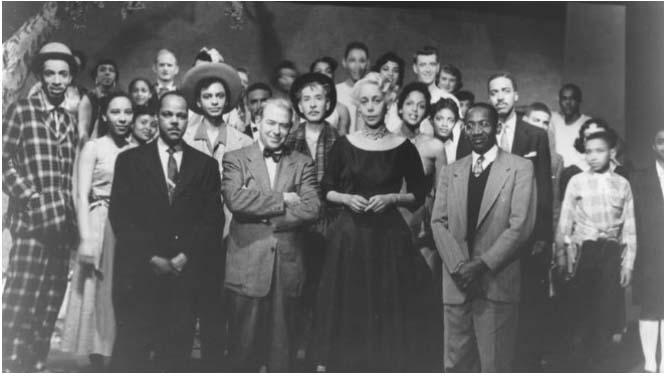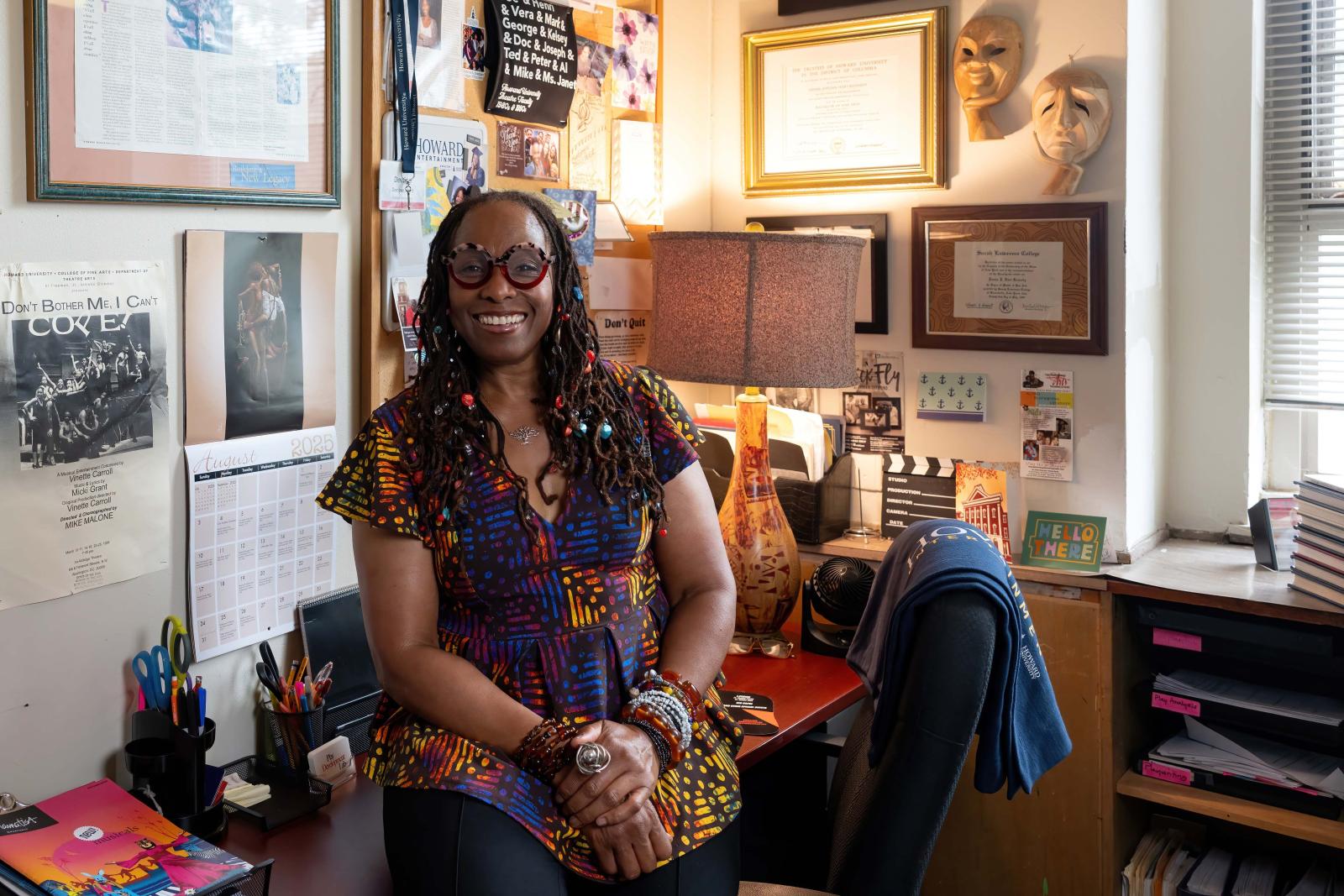For decades before the 1920s, even at historically Black colleges and universities, theatrical training meant performing the works of European playwrights. Shakespeare, the Greeks, and other white authors of the Western canon were considered the gold standard for “serious” drama, even on campuses meant to nurture Black minds.
However, at Howard University, Alain Locke — a young philosophy professor who would later be called the “Father of the Harlem Renaissance” — and Thomas Montgomery Gregory, an English professor, envisioned a new kind of theatre. Instead of simply mirroring the white classics they had been trained in, they sought to create a stage that centered Black stories and expressed the realities and beauty of Black life. This vision set the stage for a pivotal moment in Howard’s theatre history and, by extension, Black theatre more broadly. It led to a national revolution in how Black people were presented on stage and the subject matter they addressed in their productions.
Few explain Howard’s impact on Black theatre and culture more clearly than Denise J. Hart (BFA ’96), professor of theatre arts and the coordinator of playwriting and scriptwriting in the Chadwick A. Boseman College of Fine Arts.
She is the recipient of honors including the 2024 Chadwick A. Boseman Full Professor Award and the 2021 Provost’s Distinguished Service Award. A theatre scholar with 26 years of teaching experience, Hart researches the history and dramaturgy of Black performance. Through her Howard Players Theatre History Archives and digital humanities research, she’s one of the foremost anchors and documentarians of Howard’s theatrical lineage.
According to Hart’s research, Black theatre’s subject matter led to conflict in the early 20th century. W.E.B. Du Bois, for example, pushed for theatre to be unapologetically political, using the stage to expose racism through dramas on anti-lynching — the foremost issue on Black America’s political agenda at the time. (Locke and Gregory took a less aggressive approach.)
“Locke and Gregory argued for what they called ‘folk drama’ — everyday stories of middle-class Black life that humanized Black people without directly confronting white guilt,” Hart said. “They didn’t want white audiences to walk away defensive or hardened.”
In 1916, the debate came to a head. That year, Locke and Gregory joined W.E.B. Du Bois on an NAACP planning committee for a theatrical production. Du Bois pushed to stage “Rachel,” an anti-lynching play by Angelina Weld Grimké. However, Locke and Gregory resisted the social protest play. The disagreement sparked a big argument until a compromise was reached: The committee would stage “Rachel,” and then the NAACP would produce something more in line with what Locke and Gregory wanted.
“But Du Bois reneged,” Hart said. “He did not keep his promise. That infuriated Alain Locke and Montgomery Gregory.”
In response, the Howard professors created a student theatre group to compete with the NAACP productions, giving them more control over how theatre was produced. They saw Howard not just as a teaching institution but also as a place where Black theatre could take root, free from both NAACP politics and white expectations.
“They basically said, ‘Fine. We’ll do it ourselves,’” Hart said. “Howard became their laboratory and a place to experiment. In 1916, shortly after the failed NAACP comprise, they started the Ira Aldridge Literary and Dramatic Club on campus, which eventually absorbed the student-run College Dramatic Club, which started in 1909. Four years later in 1920, the name was changed to the Howard Players, with Locke and Gregory as faculty advisors. That’s how the Howard Players were born.”
In creating the troupe, Locke and Gregory used Howard to push forward a radically new vision of Black theatre — one that centered dignity, culture, and humanity instead of focusing solely on trauma. The university’s stages became the first institutional home for a movement that rejected white-defined narratives. Hart believes the shift helped lay the groundwork for the Harlem Renaissance.

Through his work with student dramatic clubs and the Howard Players from 1916 to 1925, Locke’s belief that theatre could serve as a vehicle to organize and elevate creative talent as a source of cultural inspiration and prestige was reinforced. Gregory, meanwhile, believed that theatre could help the race gain broader recognition as full citizens by showcasing their abilities as artists.
One of the more radical steps during that era was the decision to stage plays written by students, Hart noted.
“Gregory, the more pragmatic of the duo, emphasized training and leadership,” she said. “Students were trained to write, direct, and act, but the advent of Black student dramatists was the lifeblood of their shared mission. They gave students the chance to see themselves as more than props in someone else’s story.”
But the conflicts didn’t end there. Hart said Locke and Gregory ambitiously sought to create the first drama department in the country — not just the first Black drama department, but the first drama department, period.
Unfortunately, Howard’s president, J. Stanley Durkee, was not convinced and began firing elite Black faculty members one by one. Locke was fired in June 1925 right after he wrote “The New Negro,” the manifesto that would ignite the Harlem Renaissance. Gregory was pushed out too.
“It was devastating,” Hart said. “Durkee was a white president who didn’t see art — especially Black art — as vital to Howard’s mission. He was wary of anything that might stir up trouble or push Black identity too far forward.”
Without institutional support, Howard’s chance to create the first drama department collapsed, thwarting the vision of Locke and Gregory.
“And then,” Hart noted, “Yale, in 1926, swooped in supported by a million dollars in funding and beat them to it.”
When Howard’s first Black president, Mordecai Johnson, was hired, one of his first orders of business was to rehire Locke. Locke in turn sent a letter to Gregory asking him to return to Howard.
“How do you stand on the proposition?” Locke asked Gregory. “I have either a dream or a mirage of our Negro Theatre rising again from the ashes. I urge you to seriously consider coming back, - and to stipulate for a free hand rather than a full purse.”
Unfortunately, Gregory did not return, but their legacy has endured.
“Locke and Gregory staged plays that had never been seen before,” said Hart. “They started to center Black folk life. They gave students the chance to see themselves as more than props in someone else’s story.”
One of Hart’s major achievements is founding the Play Development Lab. She created the lab as a way to continue the tradition of nurturing Black storytelling at Howard. Inspired by her own teacher, Sybil Roberts, who led Howard’s playwriting lab in the late 1990s, which shaped voices like Chadwick Boseman (BFA ’00) and Kamilah Forbes (BFA ’98), Hart’s lab is designed to bring Black women playwrights to campus to develop their work alongside students.
Article ID: 2426




